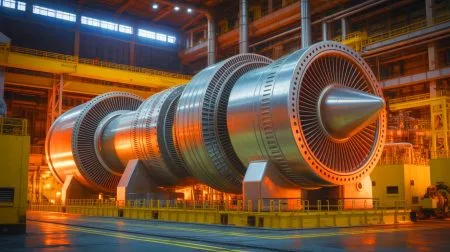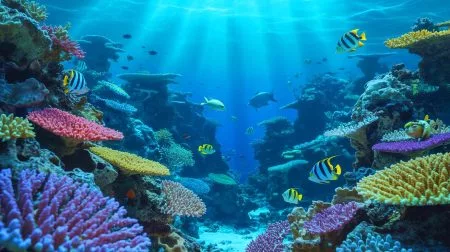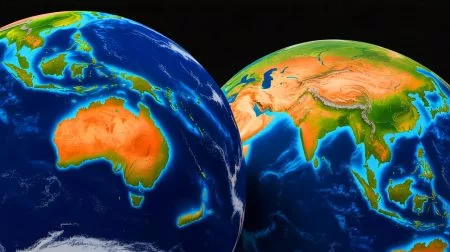About 70% of the planet is covered in oceans but only in recent decades have humans began exploring the deep sea and discovering the strange and mysterious creatures which live there. Some might even say that humans know more about outer space than about what exists in the oceans of Earth, which may to have some truth to it when discoveries of new species previously unknown to science seems to happen on nearly every expedition to the deep sea.
There have been many advancements in technology which form the basis of marine exploration today. One of the key developments during the last century was the creation of acoustic ranging technology such as sonar which gave ships the ability to search for both submarines as well as more accurately “see” underwater topography and bathymetry.
Sonar works by sending out a noise into the environment and waiting for those sounds waves to bounce off any objects in their path, before those sound waves return to sensor at their origin point. Based on how quickly the sound returns, it is possible to calculate measurements of distance or depth to gauge where an object is. During World War II and the Cold War which followed, ships were extensively refitted to have sonar capabilities and in the 1960’s and 1970’s some of the first detailed maps of the seafloor began taking shape to reveal the diverse landscapes of ridges, trenches, seamounts, and mountain ranges found on the seafloor.
Just like on land where you might expect to find different plants and animals the higher up a mountain one goes, the same is true for the ocean only in the opposite direction. The deeper one goes the more strange and bizarre some of the creatures and life strategies become in order to survive the unique environments of the ocean. Just as creatures have had to develop unique adaptations in order to survive at deeper depths, humans have had to develop machines to withstand some of the rather harsh conditions found there.
The cold, darkness and crushing pressures of the deep sea, not to mention the salty and wet environment of oceans in general, have meant that engineers in recent decades had to overcome quite a few challenges in developing technology and machines that can survive such conditions. Today the main type of underwater submersible used to explore the deep oceans is known as a remotely operated vehicle or ROV, which are often attached by wire to a research vessel and driven by pilots using shipboard controls.

ROVs range from the size of a microwave to the size of a minivan depending on what sensors and technology are attached to it. In addition to high-output lighting systems and broadcast quality cameras, some of the larger variety ROVs also come with mechanical arms, vacuum suction tubes, and “bio-boxes” for storing biological samples collected on the seafloor to be brought back to the surface for further study. Some examples include the E/V Nautilus, NOAA’s Okeanos Explorer and the R/V Falkor, all of which provide live-streams of their dive video during expeditions.
Before such ROV technology existed, our understanding of the creatures living on the seafloor came from trawling or dredging, where weighted nets were thrown over the side of a ship and dragged along the bottom of the ocean, capturing fish and whatever else in the net’s path. As one might imagine, this is highly destructive to the environment, but this method provided some of the first clues back in the late 1800’s that there was more life in the inky blackness of the deep ocean than previously suspected. Now armed with ROVs and high resolution cameras, scientists can witness the undersea ecosystems in all their glory without destroying the underwater environment.
Brilliant yellows, pinks, whites, purples and reds – there are many colorful critters living on seafloor. It is possible to find extensive sponge fields, lush corals gardens, collections of brooding octopuses, herds of squishy sea pigs, and even what looks like endless muddy landscapes sparsely occupied by flower-like hydroids and feather-like sea pens. As sunlight really only reaches about 200m (~650 ft) in the ocean, organisms living in the deeper depths do not photosynthesize for food. Instead they either eat the falling rain of particles sinking from the surface ocean made up of dead marine plants (phytoplankton) and the fecal pellets of small animals (zooplankton), or they synthesize organic compounds using energy derived from reactions involving inorganic chemicals and/or the heat found near hydrothermal vents.
This different food and energy environment means that for the most part, the deep sea tends to be sparsely populated with slow-growing and often long-lived organisms. For example, deep sea corals which create wide candelabra-like structures only grow tens of micrometers per year, meaning coral colonies reaching upwards of 2m (~6 ft) high and wide have existed for upwards of a thousand years.
Using the robotic arms and suction vacuums of ROVs to collect samples has dramatically improved our understanding of the organisms and environments that exist in the deep. However, what gets collected totally depends on the research question being asked. If one is exploring with the future goal of deep sea drilling for oil or mining for precious and rare earth metals, it might make sense to collect rocks and sediment cores to get an improved understanding of the area’s geology and minerals.
If one is exploring the diversity of creatures with an aim to describe new species, then they might try to capture an unknown animal with an arm or suction tube into one of the storage boxes for later analysis. If your goal is figuring out how ocean’s are changing with time, one of the large corals which record in their near-annual layers information about changes in the rain of food and nutrients from the surface might be what gets collected instead. With limited space on the ROV and without knowing what you might find during the first dive at a new site, it is usually the scientist in charge who determines what gets collected and what gets left behind.
Most of the ocean has never been seen with human eyes and there are likely thousands of organisms living in the deep sea just waiting to be discovered. With some of the unique evolutionary pathways these organisms possess, there are potential life-saving compounds to be discovered in creatures that we might not even know exist. We have already found in some deep sea sponges antifungal and anti-inflammatory compounds and another sponge species shows promise with possible antitumor properties.
Even if it may be challenging to sympathize with some of these big-eyed, strangely-shaped creatures of the deep sea, all the novel chemicals and compounds that marine organisms create makes discovering, understanding, and protecting the deep sea all the more important.
Did you like it? 4.5/5 (24)







